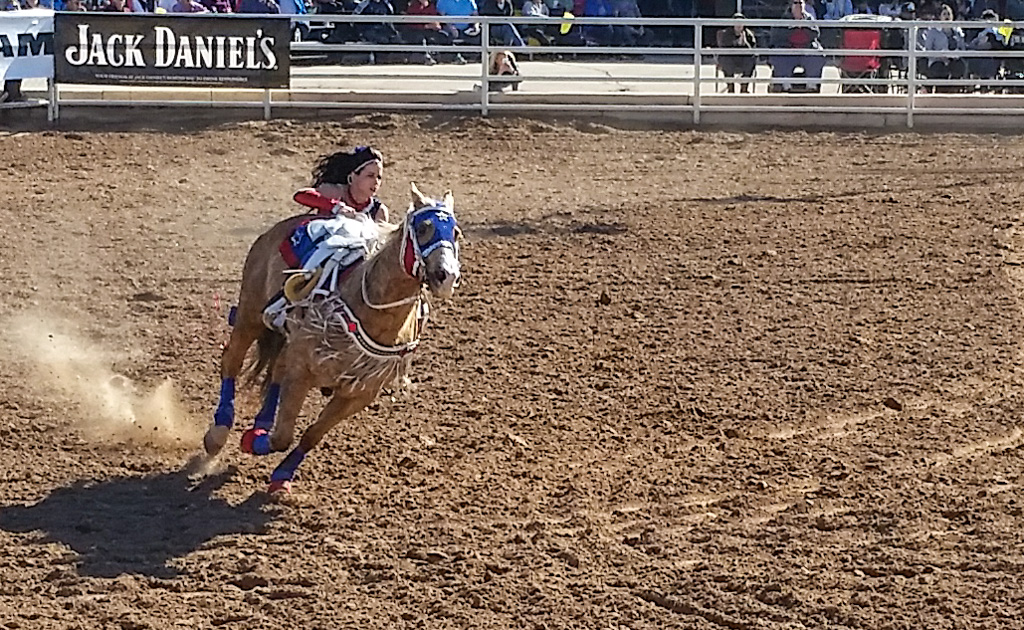I’ll start off with a warning. Rodeos celebrate western life on the range. Romanticized and stylized, sure. Exaggerated? Maybe. Rodeos are action filled and exciting.
Rodeos are not kind to animals.
However, sanctioned rodeos are subject to regulations about the treatment of their animals, and this was a sanctioned rodeo. I found this write-up interesting.
This post may not be for all of our readers. There are pictures below of the rodeo we attended. Some are cute; others may upset some people. Please use your discretion as to whether you want to continue reading.
The Yuma Silver Spur Rodeo was our first rodeo. It was entertaining to watch the events and the audience!
I had my good camera with a 400mm telephoto lens with me. “I’m going to get some GREAT pictures today!”
At the entrance gate was a large sign… cameras and photography prohibited. Yuck! Stowed the camera away in a pack. When we got in, I looked around and people seemed to be following the cameras portion of the rule, but were using their phones to capture some pics. OK, I guess they can throw us all out if they want to. So I used my phone. I didn’t get the pictures I had hoped for, but hopefully they’ll give you a sense of what we saw.
First up was tying cattle. This is a timed event; the goal is to grab a calf while it is on the run, get it down on its side, and tie three of its legs together. I can imagine that this was useful when trying to brand the calf, but don’t really know. The calf and the cowboy enter the arena through the same gate at the same time. The cowboy chases the calf on horseback, jumps off the horse onto the calf and wrestles it to the ground.

The second horse and rider are only to bring the competitor’s horse back; they are not part of the competition.
At least the goal is for the cowboy to end up holding onto the calf when he jumps off his horse. Doesn’t always work out that way!

There were also two events in the rodeo featuring women. The first of these was trick riding, demonstrated by two women. Unfortunately, we were sitting across the arena from the grandstand; the tricks were mostly staged there, so I wasn’t able to get very good pictures.

Actually, the trick riding was by one woman… and one eight-year-old girl!

Next up was the bronc riding. I have a bad back. I can’t imagine the pain these guys must endure getting thrown around like this.


So how do the cowboys learn how to ride these animals? Well, there are schools, but you could also start by riding sheep!
Here is one participant’s ride…





They are wearing helmets and flack jackets, but that still has to hurt! I would not want to be the parent of one of these kids. Hard to tell because of the helmets, but I’m pretty sure that the riders were both boys and girls.
The kid in the green shirt running alongside was there to console the rider after the inevitable “dismount,” to give words of encouragement etc.
Next up was the calf roping. This is a two cowboy event, with one putting a lasso on the calf’s head and the other then lassoing the hind legs. I was impressed that they could time their throws such that the calf’s hind legs would both be in the air.

After successfully roping the calf, the ropes were immediately slacked and the calf released.

The penultimate event was barrel racing, the other women’s event. This is a timed event, where the riders go around a triangle of barrels. They must round each barrel so that they are going more than 180° around each. The horses are as much the stars of this as the women, with sudden decelerations and changes of direction. Apparently the horse and rider are allowed to touch the barrel, but not knock it over. There is a time penalty assessed for each barrel knocked over, effectively moving them out of competition.


After the horses raced the barrels, it was time for mechanical “horses” (motocross cycles)! And one 4×4. None of the horses in the barrel race threw their rider. Can’t say as much for the motorcycles!

The last event of the day was a bit of a disappointment photographically, due to a combination of where we sat and the time of day. It was the bull “riding.” Riding is in quotes because several of the riders barely made contact with the bull before they were on the ground. We chose to sit on the back side of the field because the grandstand was already full when we arrived, and the hour was late in the afternoon. These combined to make me take pictures straight into the sun. Not optimal. But at least one came out passably.

All in all, we had a good time, made more enjoyable by attending with our friends Henk and Mary, whom we hadn’t seen in several years.
Will we go to more rodeos in the future? Don’t know… So much to do, so little time!
Hope you’re enjoying the things you’re doing!








